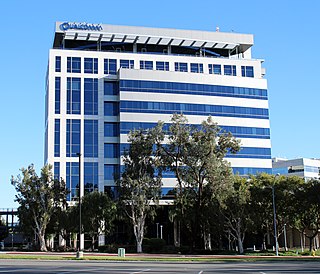Related Research Articles

Telefonaktiebolaget LM Ericsson, commonly known as Ericsson, is a Swedish multinational networking and telecommunications company headquartered in Stockholm. The company sells infrastructure, software, and services in information and communications technology for telecommunications service providers and enterprises, including, among others, 3G, 4G, and 5G equipment, and Internet Protocol (IP) and optical transport systems. The company employs around 100,000 people and operates in more than 180 countries. Ericsson has over 57,000 granted patents.

STMicroelectronics N.V. commonly referred to as ST or STMicro is a multinational corporation and technology company of French-Italian origin headquartered in Plan-les-Ouates near Geneva, Switzerland and listed on the New York Stock Exchange, on the Euronext Paris in Paris and on the Borsa Italiana in Milan. ST is the largest European semiconductor contract manufacturing and design company. The company resulted from the merger of two government-owned semiconductor companies in 1987: Thomson Semiconducteurs of France and SGS Microelettronica of Italy.

Qualcomm Incorporated is an American multinational corporation headquartered in San Diego, California, and incorporated in Delaware. It creates semiconductors, software, and services related to wireless technology. It owns patents critical to the 5G, 4G, CDMA2000, TD-SCDMA and WCDMA mobile communications standards.

The OMAP family, developed by Texas Instruments, was a series of image/video processors. They are proprietary system on chips (SoCs) for portable and mobile multimedia applications. OMAP devices generally include a general-purpose ARM architecture processor core plus one or more specialized co-processors. Earlier OMAP variants commonly featured a variant of the Texas Instruments TMS320 series digital signal processor.

Ericsson Mobile Platforms (EMP) was the name of a company within the Ericsson group that supplied mobile platforms, i.e. the technological basis on which a cellular phone product can be built. The main office was in Lund, Sweden.
ARM9 is a group of 32-bit RISC ARM processor cores licensed by ARM Holdings for microcontroller use. The ARM9 core family consists of ARM9TDMI, ARM940T, ARM9E-S, ARM966E-S, ARM920T, ARM922T, ARM946E-S, ARM9EJ-S, ARM926EJ-S, ARM968E-S, ARM996HS. Since ARM9 cores were released from 1998 to 2006, they are no longer recommended for new IC designs, instead ARM Cortex-A, ARM Cortex-M, ARM Cortex-R cores are preferred.
NXP Semiconductors N.V. (NXP) is a Dutch semiconductor designer and manufacturer with headquarters in Eindhoven, Netherlands. The company employs approximately 31,000 people in more than 30 countries. NXP reported revenue of $11.06 billion in 2021.
ARM11 is a group of 32-bit RISC ARM processor cores licensed by ARM Holdings. The ARM11 core family consists of ARM1136J(F)-S, ARM1156T2(F)-S, ARM1176JZ(F)-S, and ARM11MPCore. Since ARM11 cores were released from 2002 to 2005, they are no longer recommended for new IC designs, instead ARM Cortex-A and ARM Cortex-R cores are preferred.

Nomadik is a family of microprocessors for multimedia applications from STMicroelectronics, and later ST-NXP Wireless. It was originally based on the ARM9 ARM architecture(s), and was designed specifically for use in mobile devices.
The i.MX range is a family of Freescale Semiconductor proprietary microcontrollers for multimedia applications based on the ARM architecture and focused on low-power consumption. The i.MX application processors are SoCs (System-on-Chip) that integrate many processing units into one die, like the main CPU, a video processing unit, and a graphics processing unit for instance. The i.MX products are qualified for automotive, industrial, and consumer markets. Most of them are guaranteed for a production lifetime of 10 to 15 years.
Devices that use i.MX processors include Ford Sync, the Amazon Kindle and Kobo eReader series of e-readers until 2021, Zune, Sony Reader, Onyx Boox readers/tablets, SolidRun SOM's, Purism's Librem 5, some Logitech Harmony remote controls and Squeezebox radio and some Toshiba Gigabeat MP4 players. The i.MX range was previously known as the "DragonBall MX" family, the fifth generation of DragonBall microcontrollers. i.MX originally stood for "innovative Multimedia eXtension".
LDMOS is a planar double-diffused MOSFET used in amplifiers, including microwave power amplifiers, RF power amplifiers and audio power amplifiers. These transistors are often fabricated on p/p+ silicon epitaxial layers. The fabrication of LDMOS devices mostly involves various ion-implantation and subsequent annealing cycles. As an example, the drift region of this power MOSFET is fabricated using up to three ion implantation sequences in order to achieve the appropriate doping profile needed to withstand high electric fields.

TriMedia is a family of very long instruction word media processors from NXP Semiconductors. TriMedia is a Harvard architecture CPU that features many DSP and SIMD operations to efficiently process audio and video data streams. For TriMedia processor optimal performance can be achieved by only programming in C/C++ as opposed to most other VLIW/DSP processors which require assembly language programming to achieve optimal performance. High-level programmability of TriMedia relies on the large uniform register file and the orthogonal instruction set, in which RISC-like operations can be scheduled independently of each other in the VLIW issue slots. Furthermore, TriMedia processors boast advanced caches supporting unaligned accesses without performance penalty, hardware and software data/instruction prefetch, allocate-on-write-miss, as well as collapsed load operations combining a traditional load with a 2-taps filter function. TriMedia development has been supported by various research studies on hardware cache coherency, multithreading and diverse accelerators to build scalable shared memory multiprocessor systems.

The ARM Cortex-A9 MPCore is a 32-bit multi-core processor that provides up to 4 cache-coherent cores, each implementing the ARM v7 architecture instruction set. It was introduced in 2007.
ST-Ericsson was a multinational manufacturer of wireless products and semiconductors, supplying to mobile device manufacturers. ST-Ericsson was a 50/50 joint venture of Ericsson and STMicroelectronics established on 3 February 2009 and dissolved 2 August 2013. Headquartered in Geneva, Switzerland, it was a fabless company, outsourcing semiconductor manufacturing to foundry companies.

Linaro is an engineering organization that works on free and open-source software such as the Linux kernel, the GNU Compiler Collection (GCC), QEMU, power management, graphics and multimedia interfaces for the ARM family of instruction sets and implementations thereof as well as for the Heterogeneous System Architecture (HSA). The company provides a collaborative engineering forum for companies to share engineering resources and funding to solve common problems on ARM software. In addition to Linaro's collaborative engineering forum, Linaro also works with companies on a one-to-one basis through its Services division.

NovaThor was a platform consisting of integrated System on Chips (SoC) and modems for smartphones and tablets developed by ST-Ericsson, a 50/50 joint venture of Ericsson and STMicroelectronics established on February 3, 2009. ST-Ericsson also sold the SoCs (Nova) and the modems (Thor) separately. The application processor portion of the system was the successor of the previous Nomadik line from STMicroelectronics.

Imageon was a series of media coprocessors and mobile chipsets produced by ATI in 2002–2008, providing graphics acceleration and other multimedia features for handheld devices such as mobile phones and Personal Digital Assistants (PDAs). AMD later sold the Imageon mobile handheld graphics division to Qualcomm in 2009, where it was used exclusively inside their Snapdragon SoC processors under the Adreno brand name.

Ericsson Mobile Communications AB was a subsidiary of Ericsson, entirely focused on development of mobile phones (handsets). The major offices were located in Lund, Kumla, Raleigh, North Carolina and Lynchburg, Virginia.
RF CMOS is a metal–oxide–semiconductor (MOS) integrated circuit (IC) technology that integrates radio-frequency (RF), analog and digital electronics on a mixed-signal CMOS RF circuit chip. It is widely used in modern wireless telecommunications, such as cellular networks, Bluetooth, Wi-Fi, GPS receivers, broadcasting, vehicular communication systems, and the radio transceivers in all modern mobile phones and wireless networking devices. RF CMOS technology was pioneered by Pakistani engineer Asad Ali Abidi at UCLA during the late 1980s to early 1990s, and helped bring about the wireless revolution with the introduction of digital signal processing in wireless communications. The development and design of RF CMOS devices was enabled by van der Ziel's FET RF noise model, which was published in the early 1960s and remained largely forgotten until the 1990s.
Nexperia was the NXP Semiconductors brand for a family of processors, primarily featuring media processor system-on-chip (SoC) and media co-processors, but also briefly including highly integrated mobile (SoC) products.
References
- ↑ "STMicroelectronics and NXP Complete Deal to Create New Wireless Semiconductor Company". st.com. 28 July 2008.
- ↑ "STMicro, NXP merge $3 bln wireless chip operations". Reuters. 10 April 2008. Retrieved 14 April 2023.
- ↑ Shepard, Jeff. "Ericsson and ST Complete Deal To Create Joint Venture For Semiconductors & Platforms In Mobile Applications". EEPower. Retrieved 14 April 2023.
- ↑ Philippe Geyres (23 May 2006). "Applications – Multimedia Convergence" (PDF). Retrieved 1 May 2023.
- ↑ "ST-NXP Datasheet: STn8820 Mobile multimedia application processor" (PDF). Retrieved 1 May 2023.